
Brinley Sylvester’s c. 1737 House, Shelter Island
A conjectural restoration of the front elevation. The following features are substantiated by physical or documentary evidence: the hipped roof and chimney placement; two corner windows with segmental pediments; modillion cornice; location and dimensions of windows; clapboard siding, water table and corner boards; two-leaf front door.
——————————————————————-
Historic Structure Report, 2013, by Robert Hefner.
(Abridged, with focus on Brinley Sylvester’s original manor house.)
Sylvester Manor was built about 1737 by Brinley Sylvester, soon after he was awarded clear title to Nathaniel Sylvester’s estate. Sylvester Manor was a well developed Georgian house with its hipped-roof form; center-hall plan; paneled double entrance door; classical modillion cornice; dormers with segmental pediments; balanced façade with large windows having twelve-light sash; and fully-paneled rooms with fluted pilasters, bolection moldings, window seats and interior shutters. Sylvester Manor was the first Georgian house on eastern Long Island and is important in the context of the early Georgian houses of New England.
Brinley Sylvester had business and family ties to Newport and he looked to the most stylish houses there in designing his own house for Shelter Island. Many features of Sylvester Manor were common among early Georgian houses in the colonies, but its hipped roof, with chimneys at either end of the ridge, connect Brinley Sylvester’s house directly to Newport. In that Rhode Island port, the Jahleel Brenton House (1720) and the Abraham Redwood House (1727) had gable-on-hip roofs with chimneys flanking the ridge. This particular combination of hipped roof and chimney placement was not found in New England outside of Newport at this time. This was the design that Brinley Sylvester wanted for his new house and he achieved in an inventive way.
————————–
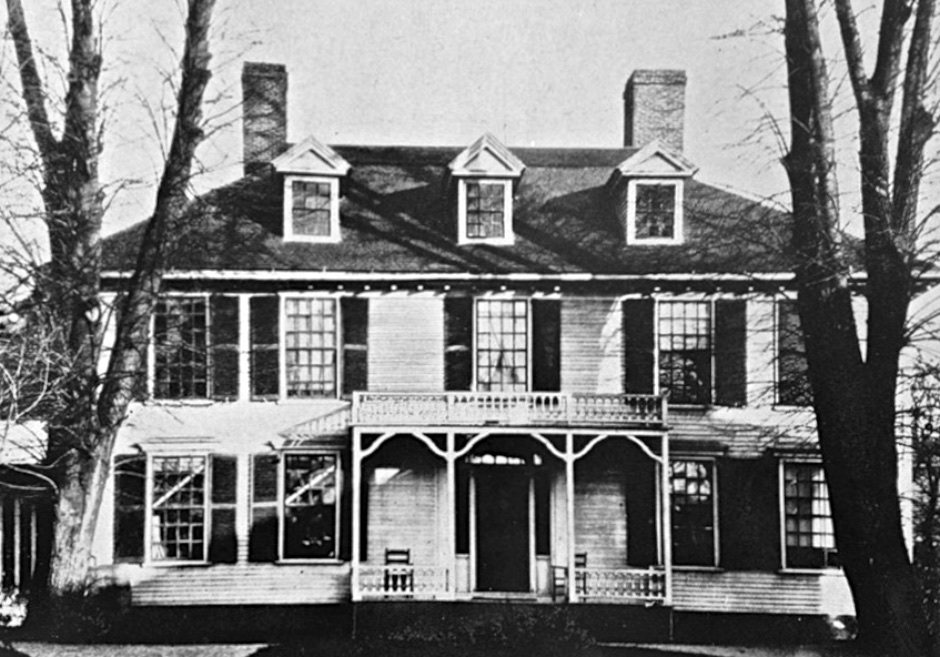 Jahleel Brenton House, Newport, Rhode Island, 1720, demolished in the 1920s. Photo: Historic American Buildings Survey.
Jahleel Brenton House, Newport, Rhode Island, 1720, demolished in the 1920s. Photo: Historic American Buildings Survey.
The context for Sylvester Manor: Georgian houses of Newport
The first known Georgian house in Newport was built by Jahleel Brenton in 1720. This large house was the earliest Newport house with a central hall and two chimneys providing back-to-back fireplaces for the rooms on either side of the hall. The Brenton House introduced the gable-on-hip roof to Newport. This was a variant of the high-style English hipped roof where the rafters rise to a small rectangular deck at the apex. At the Brenton House, the framed rectangle at the apex carried a small, low-pitched gable roof instead of a flat deck, possibly an adaptation in response to New England winters. The two chimneys at the Brenton House were built tight against either end of the small gable, again following some English examples where chimneys placed at either end of the roof deck created a strong symmetrical design. The Jahleel Brenton House introduced other exterior features associated with early Georgian design: a generally symmetrical front façade; a modillion cornice at the eaves of the hipped roof; pedimented roof dormers; large windows with twelve-over-twelve-light sash; and a front doorway framed by pilasters and a pediment. The interior introduced features that would be repeated in Newport’s finest houses built to the 1750s. The front doorway opened to a wide entry with the stairway set behind a paneled arch. The four walls of the parlor were covered with fielded paneling framed with bolection moldings. A wide bolection molding ran around the fireplace which was flanked by fluted pilasters. These pilasters, in turn, were flanked by arched doorways. A chair rail ran around the room as did a molded cornice. Windows had interior shutters that folded into recessed pockets above the window seats.
 Whitehall, Middletown, Rhode Island, 1729. The two-leaf door is feature it shared with Brinley Sylvester’s house. Photo: Richard Barons.
Whitehall, Middletown, Rhode Island, 1729. The two-leaf door is feature it shared with Brinley Sylvester’s house. Photo: Richard Barons.
In 1729 Dean George Berkeley introduced a new hipped-roof form to the Newport region when he remodeled an existing house giving it a Georgian character with a hipped roof rising to a single ridge, a modillion cornice, a double entry door within a pedimented enframement and a balanced five-bay front façade with large twelve-over-twelve-light sash. Berkeley’s house, which he named Whitehall, is in Middletown, just outside of Newport. Vincent Scully noted that Newport’s “notables of the day came to Whitehall to call” and Brinley Sylvester may well have been one of them.
Whitehall’s hipped roof with a single ridge appears to be the first of this type in New England and must have been the precedent for Sylvester Manor’s roof, which may be only the second such roof in the region. The hipped roof rising to a single ridge, instead of to a roof-top deck, was a popular form for small houses in England at this time.
Brinley Sylvester’s House in relation to the Georgian houses of Newport
Brinley Sylvester shared the Newport merchant’s idea of a fashionable house. Like the Newport houses, Sylvester Manor had a center hall with a chimney on either side, a balanced five-bay front façade with a pedimented doorway at the center, large windows with twelve-over-twelve-light sash, clapboard walls, a modillion cornice, pedimented dormer windows and fully-paneled rooms featuring a fireplace wall with a bolection molding around the fireplace, flanking fluted pilasters and a beaufat with an arched door along with window seats and folding interior shutters.
The most distinctive feature of Sylvester Manor is the strong composition of the hipped roof with a large chimney set tight against each end of the ridge. This arrangement was found in England on hipped-roof houses with roof-top decks, in Williamsburg, Virginia at the 1713 Governor’s House, which also had a roof deck, and in Newport at the 1720 Jahleel Brenton House and the 1727 Abraham Redwood House, which both had hipped roofs where a small, low-pitched gable replaced the roof-top deck.
 Governor’s House, Williamsburg, Virginia, 1706-1717, reconstructed in the 1930s. Photo: Howard R. Hollem, 1943, Library of Congress.
Governor’s House, Williamsburg, Virginia, 1706-1717, reconstructed in the 1930s. Photo: Howard R. Hollem, 1943, Library of Congress.
Brinley Sylvester planned a house of moderate size and chose to cover it with a hipped roof rising to a single ridge, following the precedent of George Berkeley’s Whitehall. But he wanted the look of the Brenton and Redwood houses where a chimney at either end of the ridge was an integral part of the well-ordered and imposing design. This combination of roof form and chimney placement, however, presented a problem for Brinley Sylvester’s housewright.
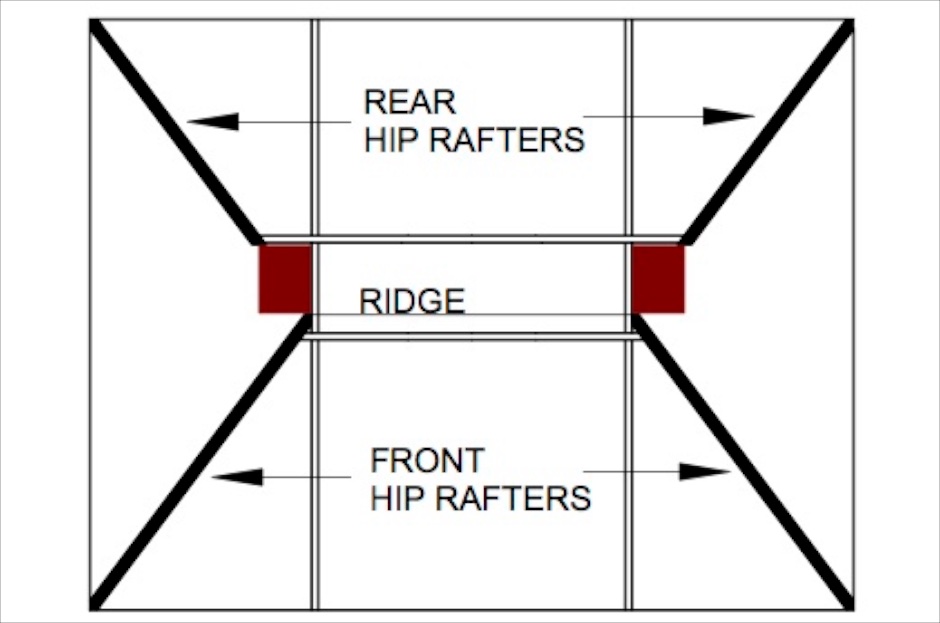
Diagram of the unique frame of Sylvester Manor. The front hip rafters reach the ridge, but the rear hip rafters are cut off by the chimneys and are supported by cantilevered purlins.
Brinley Sylvester asked his builder to place chimneys at either end of the ridge where they would cut off the rear hip rafters and prevent them from reaching the ridge as they normally would. In an unprecedented arrangement, Sylvester’s builder solved the problem by supporting the cut-off end of each rear hip rafter with the tenon of a cantilevered purlin. This inventive roof frame is unique to Sylvester Manor. It is Brinley Sylvester’s signature, telling us how determined he was to have the composition he admired in the Brenton and Redwood houses. Looking at Sylvester Manor’s hipped roof, with its ridge set between two massive chimneys, we can imagine Brinley Sylvester pressing his builder to adapt the roof frame of Whitehall to allow chimneys to be placed as they were at the Brenton and Redwood houses.
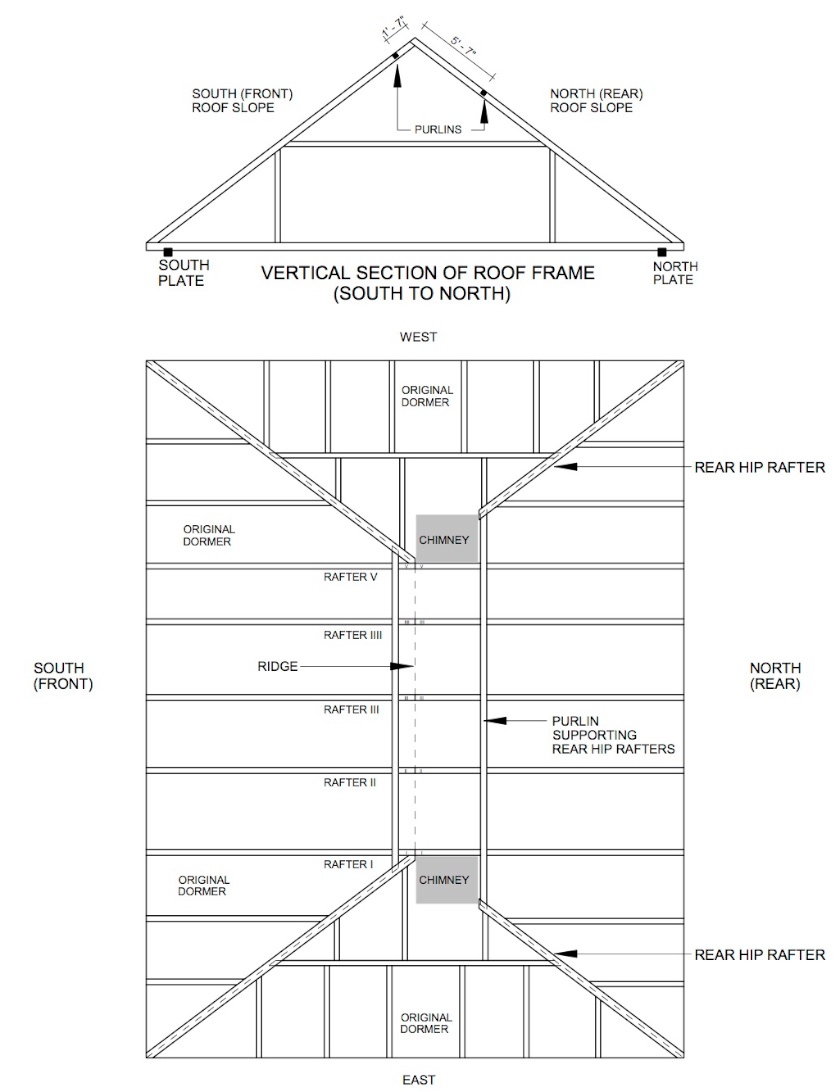
Plan view of roof frame showing rear hip rafters cut off by chimneys and supported by cantilevered purlins.
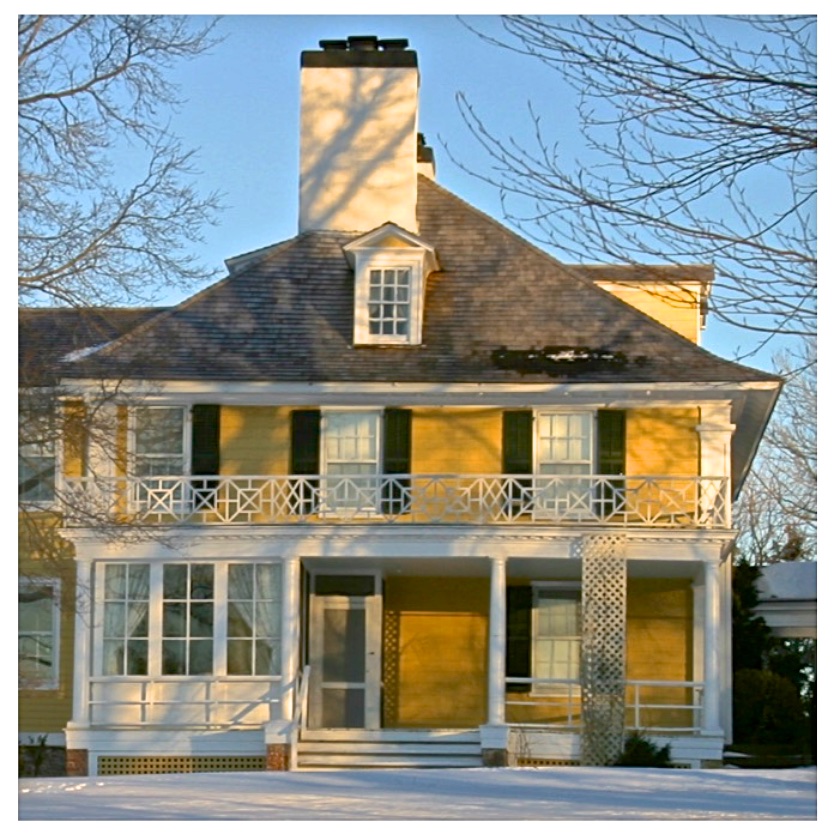 View of the west wall of Sylvester Manor showing the front hip rafter reaching the ridge, the forward face of the chimney aligning with the ridge and the chimney stack cutting off the rear hip rafter, preventing it from reaching the ridge. Photo: Andy Bush.
View of the west wall of Sylvester Manor showing the front hip rafter reaching the ridge, the forward face of the chimney aligning with the ridge and the chimney stack cutting off the rear hip rafter, preventing it from reaching the ridge. Photo: Andy Bush.
The importance of the chimney placement to Brinley Sylvester is also seen in a floor frame that allows the forward face of each chimney to align with the ridge. Across the end walls, the framing bay for the front rooms is 16 feet wide, the chimney bay is 6 feet wide and the framing bay for the rear rooms is 10 feet wide. This plan placed the front face of the chimney bay at the direct center of the house, aligning with the ridge.
While Sylvester Manor belongs in the context of the early Georgian houses of Newport, it does reflect its remote location and the more modest means of Brinley Sylvester in comparison to the merchant princes of Newport.
————————-

Section of original roof cornice, restored.
ROOF CORNICE
The classical cornice was a defining feature of Brinley Sylvester’s house and today is the only original exterior fabric to survive. The cornice is composed of a bed molding, a row of block modillions on the soffit, a fascia and a crown molding, typical of those found on other Georgian houses of the period. A tapered block nailed to the upper face of each rafter tail gives the eaves a flare that provides extra vertical face for the cornice.
————————-

Two-leaf door to Brinley Sylvester’s house exterior face, restored.
FRONT DOORWAY
Sylvester Manor had an impressive entrance with a two-leaf or double door within a classical enframement. The double door survives in the attic, but no evidence was discovered of the original pilasters or pediment within which it was hung. This two-leaf door is another example of Brinley Sylvester’s intent to build a fashionable house.
The original front door is found today hung in the doorway to the small north room in the attic. The pine paneled door retains the original dark brown finish on the interior and has a heavily-weathered exterior.
————————-
WINDOWS
The original windows, which had twelve-over-twelve-light sash, are well documented by the physical evidence: the spacing of wall studs; notches for the ears of the plank window frames in the wall studs; original exterior window shutters; original interior window trim; and the original glazed cupboard door. During Samuel S. Gardiner’s 1840s renovation, all of the windows were removed and new windows with six-light sash were installed. These nineteenth-century windows remain in place today.
Exterior window shutters
The windows of the paneled front rooms were fitted with window seats and interior shutters that folded into recesses behind the interior casings. The back rooms had plaster walls and their windows were fitted with exterior shutters.
Three original exterior window shutters were found in the attic. One shutter is loose and a matched pair of shutters is installed at a hatchway closing off the main attic from the attic of the 1908 rear addition. The shutters, with beaded rails and stiles and raised panels, have the same characteristics as the paneling of the hall and hall chamber. Panels are raised on the face visible from the exterior when open and on the interior when closed. The shutters are weathered on both sides.
There are no original interior features in the parlor (west front room) or parlor chamber to indicate the position of their windows. Undoubtedly Samuel Smith Gardiner installed new windows in these rooms at the locations of the original windows, as he had done in the hall and hall chamber.
The shutters were hung with wrought-iron H hinges, which remain in place, fastened with wrought-iron nails. Wrought-iron hooks and evidence of wrought-iron staples indicate the means of fastening the shutters in an open or closed position.
Dormer windows
The existing three dormer windows on the front roof slope and the single dormer window on each of the east and west roof slopes were installed by Samuel S. Gardiner in the 1840s. Physical evidence indicates that Gardiner’s dormers are at the same locations as the original dormers on the south, east and west roof slopes, except that on the south roof slope Gardiner added the center dormer.
————————-
Exterior finishes
The exterior of the original front door, now set in the attic, is heavily weathered, but a few traces of dark brown paint can be found along the edges where it was protected by the door stops. Beneath multiple layers of white paint on an original modillion block and its molding are traces of a dark brown pigment. Brinley Sylvester may have painted the exterior woodwork with the same brown paint used on the interior face of the front doors and on the stair balusters.
————————-

Conjectural Restoration of the First Floor Plan.
The floor plan of Brinley Sylvester’s House
Brinley Sylvester’s house had a center hall and four principal rooms on each floor. The dimensions of each framing bay gave the rooms different dimensions. Across the south wall, from west to east, was a 16’ framing bay for the west room, a 9’ bay for the hall and an 18’ bay for the east room. Across the end wall was a 16’ framing bay for the front rooms, a 6’ bay for the chimney and a 10’ bay for the north rooms.
Entry and Stairway
The broad entrance hall with its gracious stairway was perhaps the most significant feature introduced in the Newport mansions beginning with the Jahleel Brenton House in 1720.
The broad center entry was one of the great innovations which Sylvester Manor introduced to eastern Long Island. The furnishings that Brinley Sylvester, and later his daughter Mary and her husband Thomas Dering, placed in the entry confirm that this was an important furnished room where pictures were displayed on the walls.
The configuration of the original stairway is not known. The present stairway was installed in the 1870s or 1880s by Professor E. N. Horsford and all other fabric of the center hall dates from Cornelia Horsford’s 1908 renovation. Physical evidence and historical references lead to the conclusion that Sylvester Manor had a straight flight of stairs against the west wall in the approximate location of the existing stairway.
The fireplace wall retains original paneling and doors opening into the passage and closet. The large panels with bolection moldings on the chimney breast, the flanking fluted pilasters and the plain raised paneling to either side are the same treatment found in the more intact hall chamber.
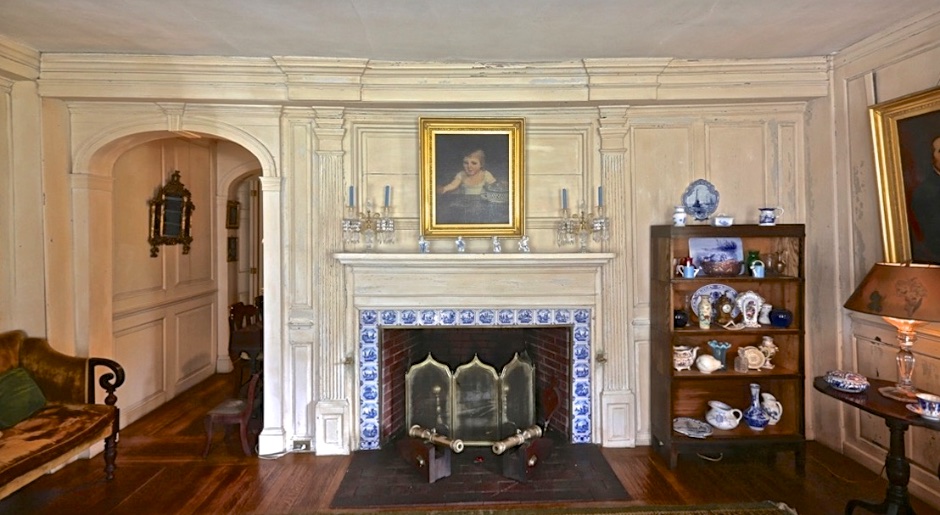 Fireplace wall paneling in Brinley Sylvester’s hall. The mantel, the panel above the mantel and the arched doorway to the left are later alterations. Photo: Jeff Heatley.
Fireplace wall paneling in Brinley Sylvester’s hall. The mantel, the panel above the mantel and the arched doorway to the left are later alterations. Photo: Jeff Heatley.
Hall
This is the room referred to as the “hall” in the 1753 inventory of Brinley Sylvester’s estate. This is the larger of the two front rooms, being two feet wider than the parlor. This room and the chamber above are the most intact of the principal rooms of Brinley Sylvester’s house. Most of the fielded paneling, the fluted pilasters flanking the fireplace, the cornice moldings and the architrave moldings around the windows and hall doorway are original. Brinley Sylvester’s blue paint is evident where more recent paint has peeled away. This blue paint is found on all the original woodwork in this room. The early date of this finish is documented by the 1758 list of repairs in which David Chesebrough refers to this as “the Bleu room.”
While the parlor may have served principally as Brinley Sylvester’s workplace, the hall may have been the room more often used for tea, dining and for Mary Sylvester’s activities during the day. The hall contained the most valuable looking glass in the house, a tea table and oval table with a higher value than the tables in the parlor and a beaufat, or china cupboard.
The “beaufat of China Ware & ca” refers to a built-in cupboard for storing and displaying china, silver and glass. With this the largest room in the house and apparently being used for tea and dining, a cupboard holding china would be expected.
The wall paneling is set in from the exterior walls to provide deep window seats for the folding shutters.
Kitchen
The fourth major first-floor room listed in the inventory of Brinley Sylvester’s estate is the kitchen, which was the west room at the back of the house. The kitchen was finished like the other back rooms with plaster walls, cased posts and girts and likely vertical-board paneling on the fireplace wall. The kitchen had a door to the entrance hall, a door to the passage leading to the parlor and back stairway, and an exterior door in the north wall.
The chimney contained a large cooking fireplace, which would typically have been about six feet wide and about four feet tall. The door to the bake oven was in the back wall of the fireplace.
The office was a storeroom at the back of the house associated with the kitchen. The inventory of Thomas Dering’s estate also includes “the office” in which a chest, a pair of scales and weights, two cases of bottles, flasks and other pantry items were stored. David Chesebrough included installing “a lock on the office doore” in his 1758 list of repairs.
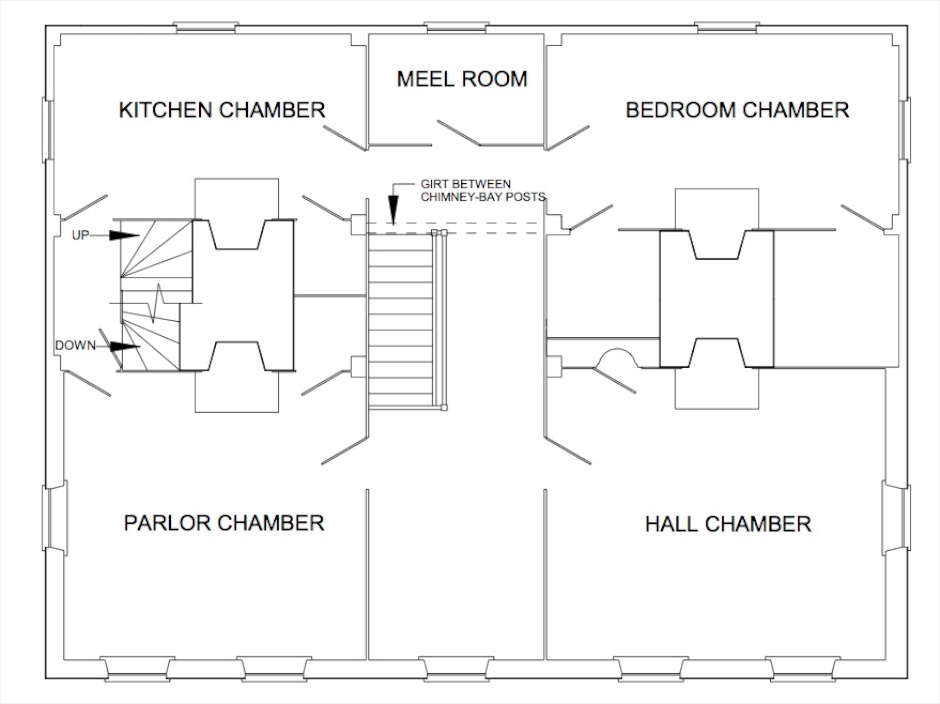 Conjectural Restoration of the Second Floor Plan.
Conjectural Restoration of the Second Floor Plan.
Brinley Sylvester’s House: Second-floor Rooms
The second floor had the same configuration of rooms as the first floor, with two large front rooms, two smaller back rooms and a small storage room at the north end of the center hallway.
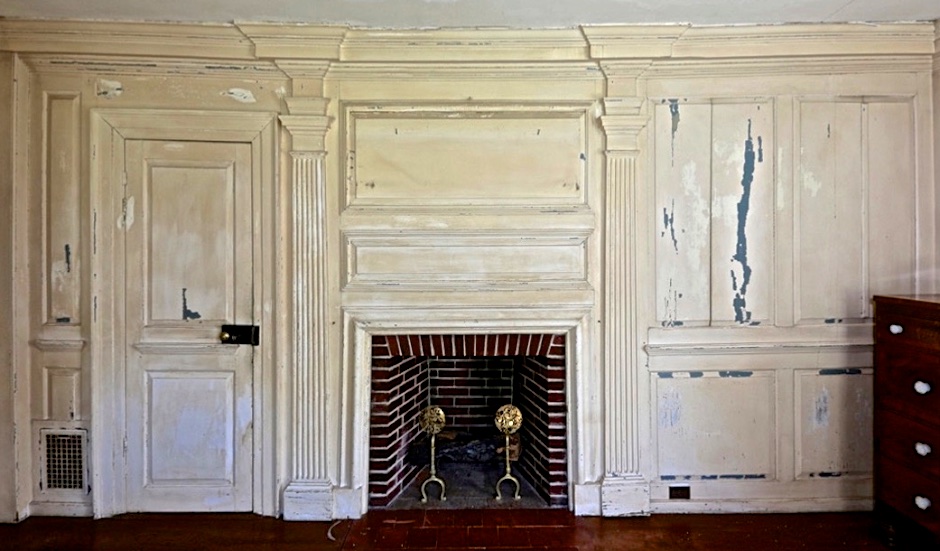 Fireplace wall paneling in Brinley Sylvester’s hall chamber. Photo: Jeff Heatley.
Fireplace wall paneling in Brinley Sylvester’s hall chamber. Photo: Jeff Heatley.
The hall chamber is the most intact room that survives from Brinley Sylvester’s house. This is the only room to retain the original paneled chimney breast with a heavy bolection molding around the firebox, two horizontal panels above, also framed with bolection moldings, and flanking fluted pilasters. Plain fielded paneling continues around the room with a chair rail dividing upper from lower panels. Raised panels vary in width from 15” to 27” for a balanced composition between windows and other wall elements. The room retains the original entry door (2’ 8” x 6’ – 6” x 1”) from the hallway and the original door (2’ – 2” x 6’ – 6” x 1”) to the closet west of the chimney. The four-panel door to the stair hall has raised panels on both sides matching those of the walls and a chair rail across the center rail continuing that molding around the room. The ghost of a thumb latch is evident. The two-panel closet door has the ghost of a H hinge that was identical to the hinge on the glazed cupboard door. Windows and doors have beaded casings with molded architraves instead of the wide bolection moldings found in the hall below. As in the hall below, significant areas of the original medium blue paint are evident on the paneling where later paint layers have peeled off.
The paneling is set out from the exterior walls to allow deep embrasures for window seats with folding shutters and so that the posts do not protrude into the room. Only the cased post in the northwest corner interrupts the paneling and cornice moldings. A crown molding runs around the room, mitered at the corners. The bed molding does the same, except that it ends against the cased post in the northwest corner. Both moldings are broken out around the chimney breast pilasters.
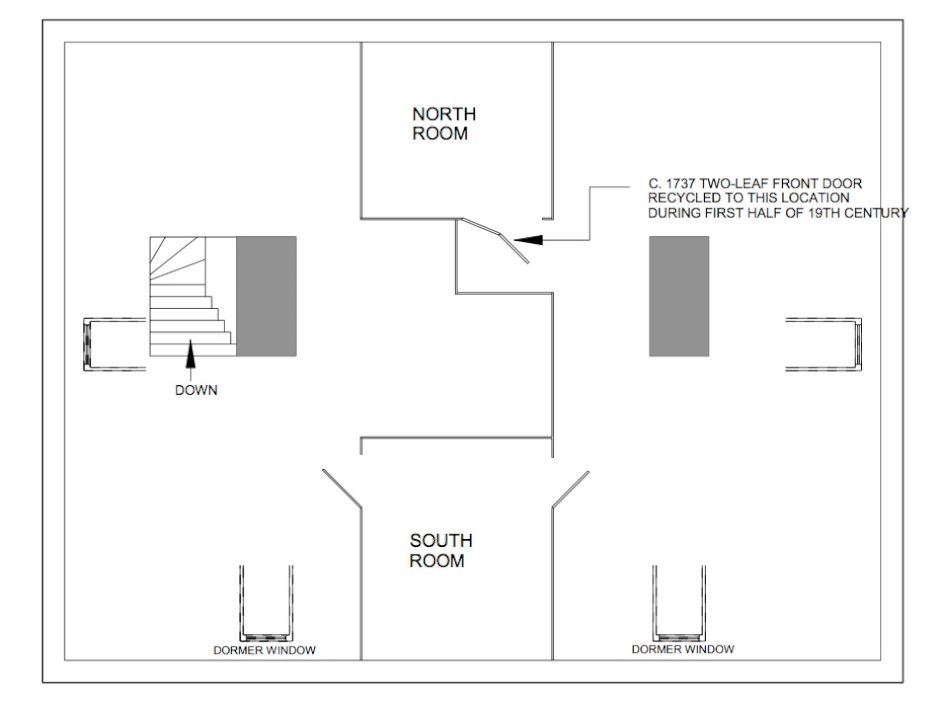 Conjectural Restoration of the Attic Plan.
Conjectural Restoration of the Attic Plan.
The attic is critical to understanding the house that Brinley Sylvester built about 1737. Here alone is the magnificent timber frame visible with the rafters, collar ties, purlins and purlin posts of the roof frame.
The only access to the attic is by the back stairway that rises in the west chimney bay providing a direct route from the kitchen.
The attic retains the original floor of 12” to 14” pine boards fastened with wrought-iron nails. Pine battens let into the floor joists align with the spaces between boards.
Board partitions extend across the center of the attic from the south wall to the north wall creating two small rooms and separating the east attic from the west attic. The principal partitions are fastened to rafters II and IIII and their collar ties and to pine cleats nailed to the floor. The wide pine boards are fastened with wrought-iron nails. These could be original features, or they may have been installed by Thomas Dering or Sylvester Dering. The partitions create two small rooms, one to the south and one to the north.
————————-
Brinley Sylvester’s House: interior paint
Sylvester Manor affords the rare opportunity to see intact eighteenth-century painted surfaces. In the hall and hall chamber, Brinley Sylvester’s blue paint is visible where the minimal coats of later paint have flaked away. The blue paint on the beaufat door, stored in the attic, was never painted over with another color. The original stair balusters and the front door were removed and stored in the attic after being painted only once or twice. The balusters and door retain the dark brown paint applied by Brinley Sylvester, possibly the same brown used in the parlor.
————————-

Sylvester Manor today has features from various periods. The form, hipped roof, chimney placement, maudlin cornice and balanced five-bay facade with center entrance are original. The windows with six-light sash and louvered shutters, the gabled dormer windows, the corner pilasters and the wall shingles were installed in the 1840s b Samuel S. Gardiner. Professor Even N. Horsford was responsible for the wide, bracketed eaves and the tradition of yellow paint on the shingles. The front porch, front door and side porches, designed by Henry Bacon, were added by Cornelia Horsford in 1908.
—————————–
*Historic Structures Report copyright Robert Hefner, abridged from the original document, to focus on Brinley Sylvester’s Manor House of 1737. The Report contains additional information about that house, including room content details, as well as subsequent additions & renovations to the Manor House.
—————————–
Sylvester Manor Historic Structure Report (March 2013) courtesy of Sylvester Manor & Robert Hefner.
—————————–
Visit: www.sylvestermanor.org
Also, AAQ’s Landmarks — Sylvester Manor, 1737, Shelter Island
___________________________________________________________
